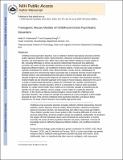Transgenic mouse models of childhood-onset psychiatric disorders
Author(s)
Robertson, Holly Rochelle; Feng, Guoping
DownloadFeng_Transgenic Mouse.pdf (422.3Kb)
OPEN_ACCESS_POLICY
Open Access Policy
Creative Commons Attribution-Noncommercial-Share Alike
Terms of use
Metadata
Show full item recordAbstract
Childhood-onset psychiatric disorders, such as attention deficit hyperactivity disorder (ADHD), autism spectrum disorder (ASD), mood disorders, obsessive compulsive spectrum disorders (OCSD), and schizophrenia (SZ), affect many school-age children, leading to a lower quality of life, including difficulties in school and personal relationships that persist into adulthood. Currently, the causes of these psychiatric disorders are poorly understood, resulting in difficulty diagnosing affected children, and insufficient treatment options. Family and twin studies implicate a genetic contribution for ADHD, ASD, mood disorders, OCSD, and SZ. Identification of candidate genes and chromosomal regions associated with a particular disorder provide targets for directed research, and understanding how these genes influence the disease state will provide valuable insights for improving the diagnosis and treatment of children with psychiatric disorders. Transgenic mouse models are one important approach in the study of human diseases, allowing for the use of a variety of experimental approaches to dissect the contribution of a specific chromosomal or genetic abnormality in human disorders. While it is impossible to model an entire psychiatric disorder in a single mouse model, these models can be extremely valuable in dissecting out the specific role of a gene, pathway, neuron subtype, or brain region in a particular abnormal behavior. In this review we discuss existing transgenic mouse models for childhood-onset psychiatric disorders. We compare the strength and weakness of various transgenic mouse models proposed for each of the common childhood-onset psychiatric disorders, and discuss future directions for the study of these disorders using cutting-edge genetic tools.
Description
Available in PMC 2012 April 1.
Date issued
2011-04Department
Massachusetts Institute of Technology. Department of Brain and Cognitive Sciences; McGovern Institute for Brain Research at MITJournal
Journal of Child Psychology and Psychiatry
Publisher
John Wiley & Sons, Inc
Citation
Robertson, Holly R., and Guoping Feng. “Annual Research Review: Transgenic Mouse Models of Childhood-Onset Psychiatric Disorders.” Journal of Child Psychology and Psychiatry 52, no. 4 (April 2011): 442–475.
Version: Author's final manuscript
ISSN
00219630